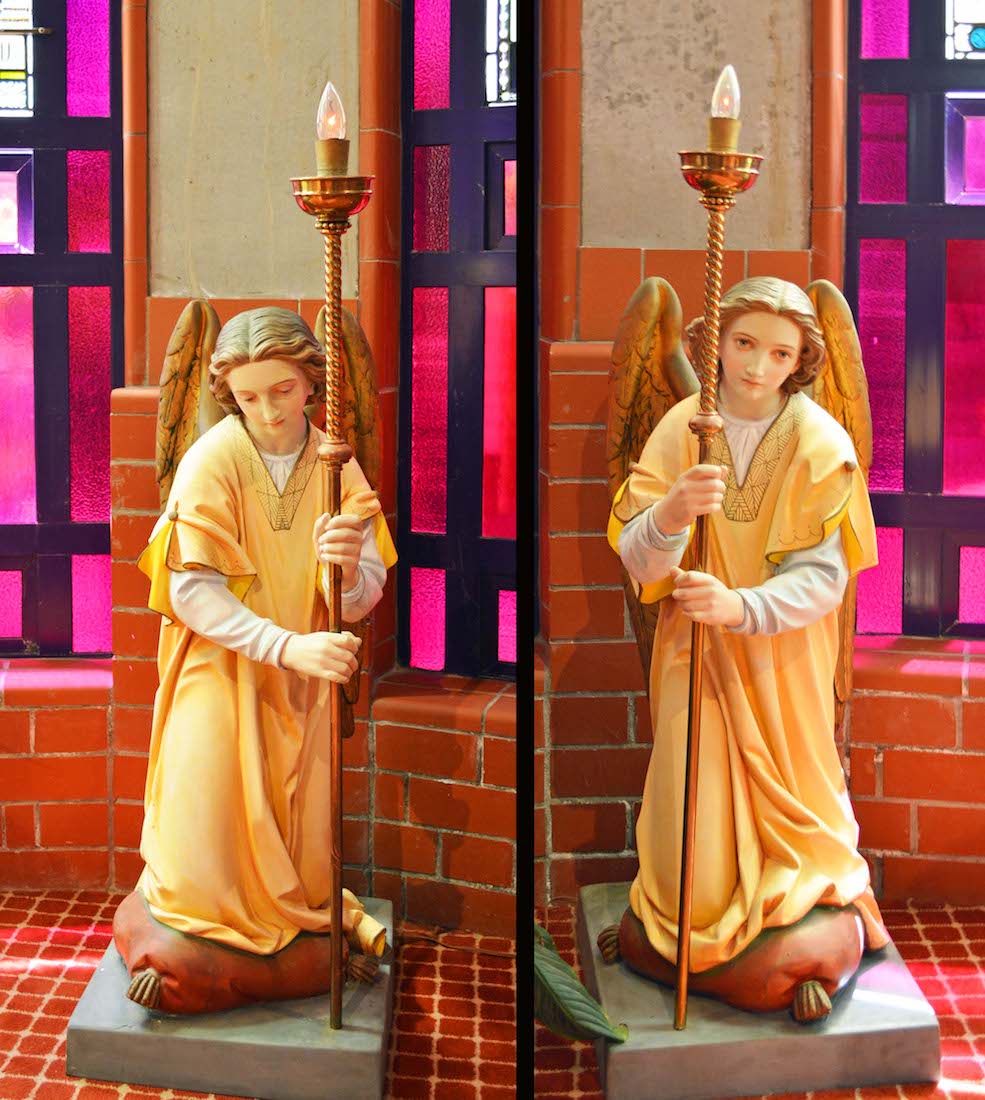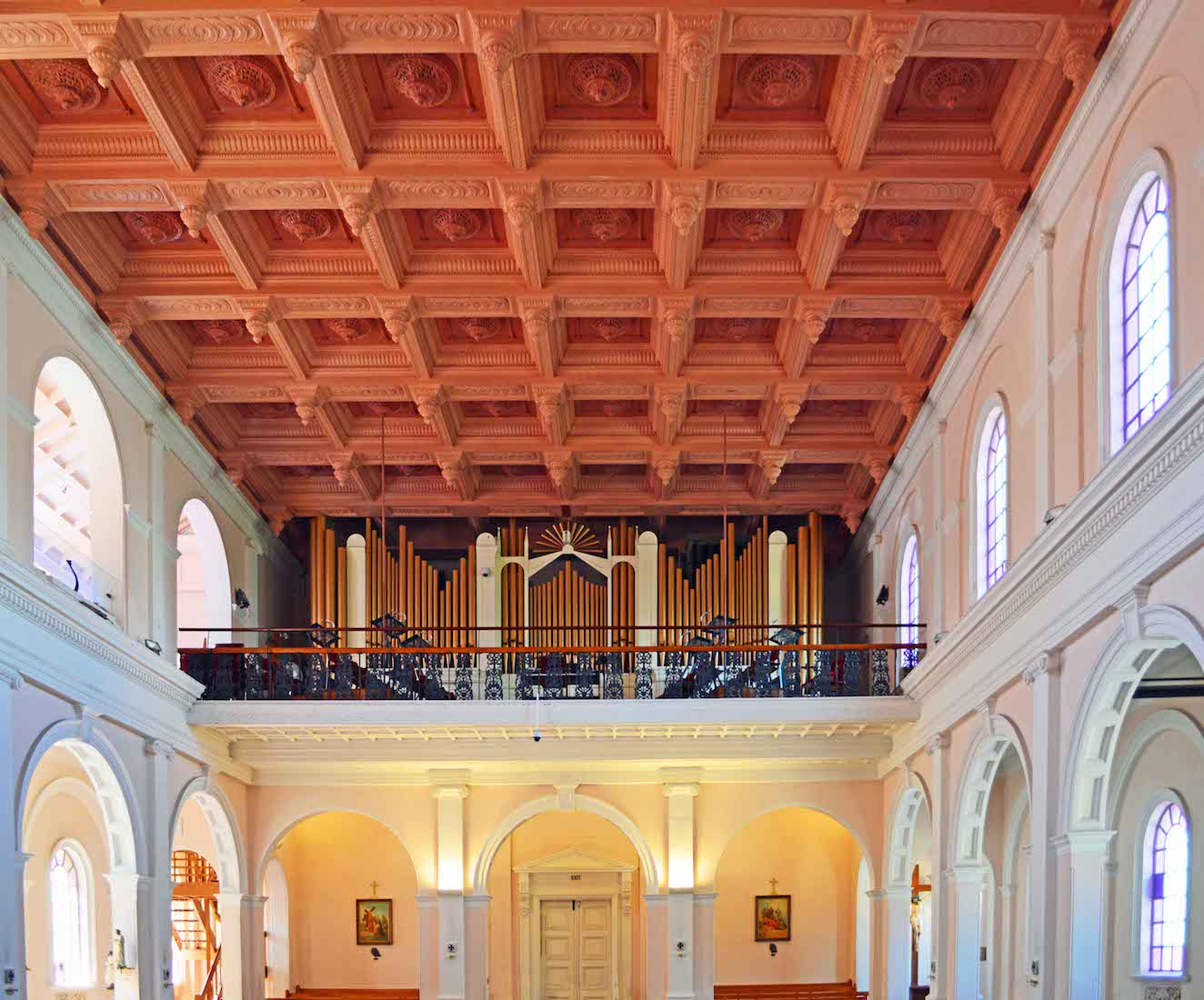
We enter the Cathedral and stand in the South aisle, separated from the main nave by solid columns. Here at the entrance are small statues of the Four Evangelists. These originally stood under the first High Altar of the present cathedral. PLAN
23. CHAPEL
The Chapel can accommodate some 60 worshippers. Looking across towards the doorway through to the Hall, we notice an icon and a metal dancing figure.
24. ICON
The fine icon of the Sacred Heart of Jesus and St Mary his mother is by contemporary iconographer, Michael Galovic, and was installed in 2007. It was given in memory of Veronica Mary Theresa Kelleher, 1928– 2004.
25. DANCING FIGURE
I can find no reference to this dancing figure, but I assume is it is the Risen Christ – is that a crown of thorns? To me the figure expresses victory and great joy.
26. CHAPEL WINDOWS
The chapel houses five examples of fine English Victorian stained glass from the studios of the Atkinson Brothers. The windows ‘ ... are a unique collection as no other building in the world contains more than two from these same workshops’. At centre is the tabernacle, covered during this time before Easter.
27. ANGELS
Two delightful angels keep watch, one on either side of the tabernacle.
28. WINDOWS
We look more closely at the windows. The central window is decorated with abstract designs. The other windows are of saints, two on each side. The saints are from the left St Patrick (with clover leaf and defeated snake under foot); St John (writing his gospel, and with his eagle insignia); St Francis Xavier (missionary and church builder); and St Peter (with the Keys of the Kingdom).
29. CRUCIFIX
On the East wall of the Chapel hangs an unusual crucifix with a golden figure of Christ hanging on a Cross with bevelled ends.
30. HOLY OILS
Finally, in the East wall of the Chapel is a small space or aumbry where the holy oils (called Chrism) are kept. The aumbry is backed by a panel with a gold sculptured image of Christ on it. This panel was a door, once part of the tabernacle of the High Altar of old St Mary's Cathedral. The front of the aumbry has a wide red and yellow, glass, mosaic border around the glassed-in space where can be seen the three glass, amphora-like, Chrismaria containing the holy oils. These vessels and their contents are bathed in a sombre green light.
31. NAVE
This is not a typical nave, but we will use the word anyway. There are two crossing aisles with a font at the centre. The cross aisle leads out to the Hall at right. Strong round arches separate the nave from the side aisles. We note the large pulpit at front right, and (just seen) windows of the Blessed Sacrament Chapel. How different this Cathedral is!
32. FONT
The font is of a simple design and solid construction. The bowl and rim are lined with small tiles, and the supporting column matches the exterior pillars.
33. ORGAN
If we turn around and look back at the West wall, we see the choir loft, and an array of organ pipes behind. The Cathedral Grand Organ was designed and built by Arthur Hobday in 1905 and has been revised and enlarged since with the changing needs of the cathedral. The roof is a heavily decorated lattice grid in a dark shade which contrasts pleasingly with the white walls.
34. STATIONS OF THE CROSS
Around the walls of the nave are found the traditional 14 Stations of the Cross, used as an aid to contemplation, particularly around Easter. Beneath the Stations is a set of 14 bronzes, Mater Dolorosa, designed by Wellington sculptor, Eve Black, depicting Mary's sorrow as she witnessed her son's journey to the Cross and Grave.
35. CRUCIFIX
In the North West corner of the nave stands a large crucifix. A bronze plaque can be seen on the adjacent wall. On the nearer column is a small Maltese cross. There are several of these little crosses, marking the consecration of the cathedral.
36. IN MEMORY OF
Jan Pawel II (1920 – 2005) was the first non-Italian pope since the 16th century. He was one of the most influential leaders of the 20th century. The plaque was presented by the Polish Embassy and Community in NZ. It is unclear whether or not the crucifix was part of this presentation.
37. NORTH AISLE
Looking West, the North aisle runs back to the crucifix. On the near left column are two memorial tablets – in fact three – one is hidden from view. These memorial tablets (one in English and two in Latin) relate to Bishop Philippo Viard, the first Bishop of Wellington, who died in 1872 and is buried in the Cathedral.
38. MEMORIAL TABLETS
The tablet on the right, which occurs on the reverse side of this column, gives details in English about the life of Bishop Philippe Viard, 1809 – 1872.
40. AMBO
On the North side of the front platform is the ambo – a raised speaking platform used for the reading of Scripture. The fine hanging in front carries the letters IHS – the first three letters of ‘JESUS’ in Latinized Greek. We glimpse the organ console tucked in behind the ambo.



















